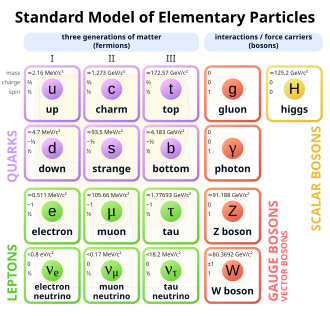用户:Wikijb/沙盒
外观
| 这是Wikijb的用户沙盒。用户沙盒是用户页的子页面,属于用户的测试区,不是维基百科条目。 公用沙盒:主沙盒 | 使用指南沙盒一、二 | 模板沙盒 | 更多…… 此用户沙盒的子页面: 外观选项: 用字选项: 如果您已经完成草稿,可以请求志愿者协助将其移动到条目空间。 |
物质
[编辑]定义
[编辑]根据原子
[编辑]根据物质的物理和化学结构,“物质”的定义是:“物质由原子组成”。[1]这种原子物质(atom matter)有时也被称为普通物质(ordinary matter)。例如,去氧核糖核酸(DNA)在这个定义下是物质,因为它们是由原子组成的。这个定义可以被扩展成涵盖原子以外的离子和分子,包括电浆(离子的气体)和电解质(离子溶液)。 使用这个扩展的定义相当于采用质子、中子和电子的定义。
根据质子、中子、电子
[编辑]更精细的“物质”定义如下:物质是由‘原子和分子的组成成分’组成的,意即,任何由带正电的质子、电中性的中子和带负电的电子构成的东西。[2]然而,这个定义超越了原子和分子,包括由这些构建块组成的物质,而不仅仅是原子或分子,例如旧型阴极射线管电视中的电子束,或者是白矮星上的物质(通常有简并态电子和碳、氧原子核)。 在微观层面上,组成质子、中子和电子等物质的“粒子”遵守量子力学定律并展现出波粒二象性。 从更深层的观点来看,质子和中子的组成成份是夸克以及能使夸克结合在一起的力场(胶子),这产生了下一个定义。
根据夸克和轻子
[编辑]
从上面的讨论中可以看出,所谓的“普通物质”在过去往往都是根据它的结构或构成要素去定义的。如果因循这一传统,在基本粒子的尺度下,物质的定义可以表述为:“普通物质是由夸克和轻子组成的一切”,或者“普通物质是由除反夸克和反轻子之外的任何基本费米子组成的一切”。[3][4][5]
参考文献
[编辑]- ^ G.F. Barker. Divisions of matter. A text-book of elementary chemistry: theoretical and inorganic. John F Morton & Co. 1870: 2. ISBN 978-1-4460-2206-1.
- ^ M. de Podesta. Understanding the Properties of Matter 2nd. CRC Press. 2002: 8. ISBN 978-0-415-25788-6.
- ^ B. Povh; K. Rith; C. Scholz; F. Zetsche; M. Lavelle. Part I: Analysis: The building blocks of matter. Particles and Nuclei: An Introduction to the Physical Concepts 4th. Springer. 2004. ISBN 978-3-540-20168-7.
Ordinary matter is composed entirely of first-generation particles, namely the u and d quarks, plus the electron and its neutrino.
- ^ B. Carithers; P. Grannis. Discovery of the Top Quark (PDF). Beam Line. 1995, 25 (3): 4–16.
- ^ Tsan, Ung Chan. What Is a Matter Particle? (PDF). International Journal of Modern Physics E. 2006, 15 (1): 259–272. Bibcode:2006IJMPE..15..259C. doi:10.1142/S0218301306003916.
(From Abstract:) Positive baryon numbers (A>0) and positive lepton numbers (L>0) characterize matter particles while negative baryon numbers and negative lepton numbers characterize antimatter particles. Matter particles and antimatter particles belong to two distinct classes of particles. Matter neutral particles are particles characterized by both zero baryon number and zero lepton number. This third class of particles includes mesons formed by a quark and an antiquark pair (a pair of matter particle and antimatter particle) and bosons which are messengers of known interactions (photons for electromagnetism, W and Z bosons for the weak interaction, gluons for the strong interaction). The antiparticle of a matter particle belongs to the class of antimatter particles, the antiparticle of an antimatter particle belongs to the class of matter particles.